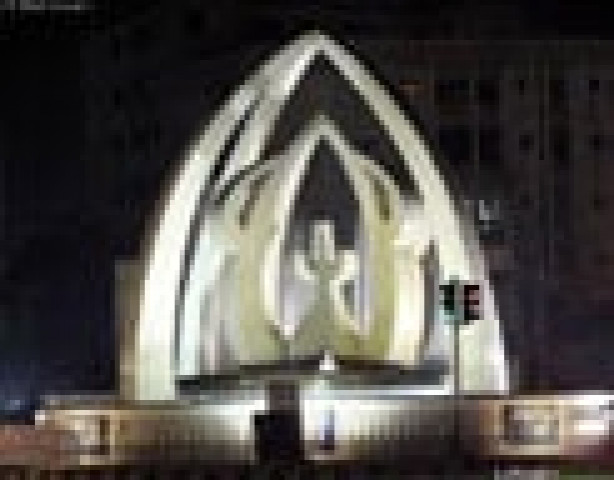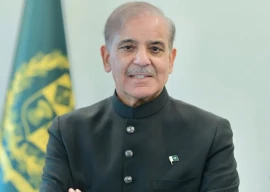
Much like the entity it calligraphically symbolised, Allah walli chowrangi will remain in the hearts and minds of the people of Karachi even though it has no physical presence - anymore.
Its legacy will endure because it has been used a reference point for anyone offering directions in the vicinity of Tariq Road. But a little over a week ago, the four-sided 25-feet tall rendition of the word ‘Allah’ at the roundabout, was broken into eight pieces and dumped in the car park of Hill Park. The monument, which was about 40 feet in diameter, had to be removed as it was located on Shahrah-e-Quaideen that was undergoing a much-needed 42-million-rupee facelift. Indeed, as vehicular traffic swelled over the years, frequent jams developed at the roundabout which should have been a box junction. Additionally problematic was the fact that it was located on a stormwater nullah, according to non-profit Shehri’s Amber Alibhai.
The elegant structure was designed by the late Ozzir Zuby whose son Danish Azar explains wanted to reflect the concept of God being omnipresent. “This was the message. Allah is ever present and everywhere,” he told The Express Tribune. “Being able to read [the word] from four sides meant you could see Him all around.”

It is a mark of the impact of this design that it has been copied across Karachi and beyond. It can be found in awkwardly rendered off-scale concrete versions in mosques, on buildings and homes and even smaller roundabouts. While architect Shahid Abdulla said he wouldn’t necessarily call it a masterpiece, it was one of “the most copied designs” in the country. “It was the common people who gave it value,” he added.
The chowrangi was part of a beautification project in late 1989. Then mayor, Farooq Sattar, had tasked a committee with proposing monuments for roundabouts, recalls Professor Dr Noman Ahmed of NED University’s architecture department. “The choice of this design was not made considering the aesthetic requirements of the city. The sacred name was preferred because of its larger public appeal,” he explained. “But the design was so carefully worked out that it doesn’t obstruct the vision of drivers coming from any direction.”
Over two decades the symbol gained so much currency that town planner Arif Hasan believes people will always refer to the spot as Allah walli chowrangi even though it is gone. “It was the same case with Lucky Star,” he said, referring to the roundabout on Sir Ghulam Hussain Hidayatallah Road. “There used to be large billboard for Lucky Star cigarettes, which were the second cheapest after K2. People just remembered that.”
Residents of Karachi such as Ramsha Kohati are sad to see it go. “I suppose this was one of the most famous landmarks in Karachi, and now as it has been removed,” she wrote The Express Tribune. “I am sure you understand how important this landmark has been for the people of Karachi.” She is not alone. Some concerned citizens have approached Danish Zuby with the idea of starting a public campaign to save it.
For its part, the Karachi Metropolitan Corporation said it had to be removed. “The landmark has only been replaced. We will re-install it at Hill Park,” assured spokesman Sajid Hasan. “I don’t think there is any harm in removing it for the sake of development.” Perhaps unbeknownst to Hasan, his words drive at the heart of an urban debate. Should popular heritage be sacrificed at the altar of the asphalt gods? Town planner Tasneem Ahmed Siddiqui, who is best known for his work in the low-cost Khuda ki Basti retorted: “The government is just bulldozing everything in the name of development. Corrupt officials want to spend money, all their time on road projects because of the kickbacks.”
For whatever it is worth, though, the KMC spokesman assured that it would be put back together again.
Zuby would have been heartbroken to see it go. His son Danish, an artist and interior designer himself, said that much like other artists, his father was sensitive about his work. “And when he felt he wasn’t getting the appreciation [he deserved] he closed himself in his own world.” Ozzir Zuby is no more and neither is one of his most endearing contributions to Karachi’s landscape. But neither is likely to be forgotten any time soon.
Ozzir Zuby (1922-2001)
Ozzir Zuby was born in Kasur in 1922. He graduated in fine art from the Mayo School of Arts, Lahore and later earned a scholarship to complete his post-graduate work from Accademia di Belle Arti in Italy. Zuby was a sculptor and painter which is why his talent in calligraphy shuttled between two and three dimensional art. Some of his sculptures include those of Begum Ra’ana Liaquat Ali Khan, Ahmed Nadeem Qasmi, Faiz Ahmed Faiz and Ahmed Faraz. Zuby was also a graphic designer and did the covers of hundreds of Urdu books. One setback changed Zuby forever; his mural, ‘The Awakening’, was plagiarised in 1967. He passed away in 2001.
Published in The Express Tribune, December 17th, 2012.
View more of Ozzir Zuby's work here.








1726054615-0/OpenAI-(2)1726054615-0-270x192.webp)









COMMENTS
Comments are moderated and generally will be posted if they are on-topic and not abusive.
For more information, please see our Comments FAQ